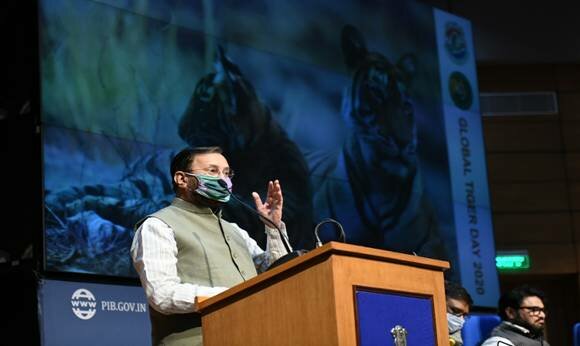Javadekar releases Tiger Census Report
India now in leadership role in Tiger Conservation; will share best practices with Tiger range countries: Javadekear

Javadekar releases Tiger Census Report
New Delhi: Union Environment Minister Prakash Javadekar released the detailed report of Tiger Census on the eve of Global Tiger Day (July 29) on Tuesday.
Speaking on the occasion, he said that the tiger is an incredible part of the nature and the increased number of the big cats in India reflects equilibrium in the nature.
Javadekar said that tigers and other wild life are a kind of soft power India has to show on the international front. Despite several constraints such as less land mass, India has eight percent of bio-diversity because the country has a culture of saving and preserving the nature, trees and its wild life. Noting that wildlife is a natural wealth, he said that it is praise worthy that India has 70 percent of world’s tiger population. India is tirelessly working with all 13 tiger range countries towards nurturing the tiger.
Javadekar also announced that his Ministry is working on a programme in which efforts would be made to provide water and fodder to animals in the forest itself to deal with the challenge of human-animal conflict which is causing deaths of animals. For this LIDAR based survey technology will be used for the first time. Lidar is a method for measuring distances by illuminating the target with laser light and measuring the reflection with a sensor.
Highlighting the keystone nature of the tiger, a poster on presence of small cats was also released by him. With the presence of nearly 30 percent of India’s tigers outside tiger reserves, India had embarked upon assessing management interventions through the globally developed Conservation Assured Tiger Standards (CATS) framework, which will now be extended to all fifty tiger reserves across the country.
Javadekar releases Tiger Census Report
Speaking on the occasion, Minister of State of Environment, Babul Supriyo said, human- animal conflict can be avoided but it cannot be ruled out in the country. He said that frontline officials have done commendable job in raising the numbers of tiger in the country.
The detailed report of the 4th All India Tiger Estimation is unique in the following ways;
- Abundance index of co-predators and other species has been carried out which hitherto was restricted only to occupancy
- Sex ratio of tigers in all camera trap sites has been carried out for the first time.
- Anthropogenic effects on tiger population have been elaborated in a detailed manner.
- Tiger abundance within pockets in tiger reserves has been demonstrated for the first time.
Javadekar releases Tiger Census Report
The Heads of the Governments of Tiger Range countries at St. Petersburg, Russia, had resolved to double tiger numbers across their global range by 2022 by signing the St. Petersburg declaration on tiger conservation. During the said meeting it was also decided to celebrate July 29 as Global Tiger Day across the world, which is since, being celebrated to spread and generate awareness on tiger conservation.
During Global Tiger Day 2019, it was a proud moment for India as the Prime Minister declared to the world fulfilment of India’s resolve as it had doubled its tiger numbers four years in advance to the target year highlighting resolute action taken by all concerned. India’s tiger population now stands at 2967 which is 70 percent of the global tiger population. A feather in India’s cap was added with the Guinness World Records recognizing the country’s efforts as the world largest camera trap survey of wildlife.
Javadekar releases Tiger Census Report
The detailed report assesses the status of tigers in terms of spatial occupancy and density of individual populations across India. In addition to the summary report released by the Prime Minister on the “Status of Tigers in India” in July 2019, this detailed report compares information obtained from the earlier three surveys (2006, 2010, and 2014) with data obtained from the 2018-19 survey to estimate population trends at country and landscape scales, patch colonization and extinction rates along with information on likely factors responsible for changes in tiger status at the fine spatial resolution of 100 km.
The report evaluates the status of habitat corridors connecting major tiger populations and highlights vulnerable areas that require conservation attention for each landscape. The report provides information on major carnivores and ungulates regarding their distribution and relative abundance.






